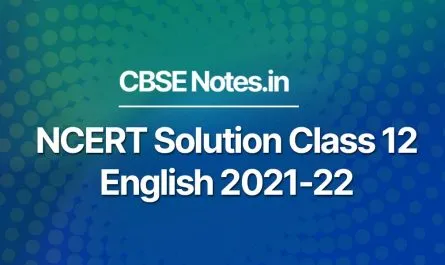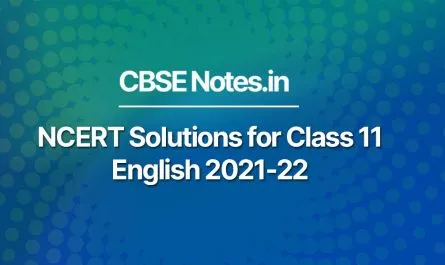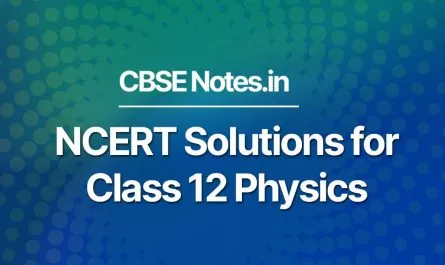NCERT Solutions for Class 12 Chemistry: Chemistry being an objective subject, it can be scored highly for CBSE students for Class 12. CBSE Notes NCERT Solutions for Chemistry for Class 12 are offered chapter-wise in this article. Furthermore, these Free NCERT-Solutions for Chemistry for Class 12 solve every question from the newest version of the NCERT textbooks. You will find solutions to more complex questions & issues to the solutions. NCERT Solutions for Chemistry for Class 12 are approved by more qualified team members & thus they are simple to depend on.
Chemistry is extra more than the Science language. Here at CBSE Notes, we’ve ensured that our solutions will reflect similarly. We purpose to assist students in answering questions correctly, with the help of a logical approach & methodology. NCERT Solutions offers ample material which allows students to have a strong base on the subject details.
NCERT Solutions for Class 12 Chemistry
Chapter 1 : The Solid State
In this chapter one, the student will have more details about the solid state. It contains 11 subtopics. Furthermore, this chapter concentrates on crystalline & amorphous solids and solids imperfections. It explains unit-cell in detailed information, & then builds up to explain its solid state. Solutions are made in agreement with the NCERT text. This justifies the explained concepts in the textbook, and as a result, the student’s fundamentals will be reinforced.
Here, you will learn the grouping of solids based on various binding forces including molecular, ionic, metallic, and covalent solids, crystalline, and amorphous solids. Unit-cell in 2-dimensional & 3-dimensional lattices, the density of unit-cell calculation, packing efficiency, packing in solids, number of atoms in a unit cell in a cubic unit cell, voids, & point defects.
Chapter 2- Solutions
Here, you will find facts about various kinds of solutions & laws which are linked to the solutions. Furthermore, you will find out the amount of CO2 that’s present in soda water as per provided information or the way to calculate the dissociation-constant of fluoro-acetic acid. Other concepts which will be studied in this chapter solutions include the solubility of gases to liquids, Can’t Hoff factor, osmotic pressure, and Raoult’s law.
Chapter 3: Electrochemistry
This chapter is comprised of 15 questions that assist students to understand concepts of dissociation degree including iron rusting is the same as setting up an electrochemical cell. Moreover, there are 18 exercises where the students will be required to find the final product of electrolysis, calculate the standard cell potential of a galvanic cell, arrange the metals in good order, etc. Furthermore, this chapter explains some relationships that are there between electricity & chemicals. The student will be guided on how electricity is produced via chemical reactions. Also, the student will be taken through the use of cells & certain batteries plus their constructions.
Other subtopics which are included in this chapter include:
Electric potential– Study how to find the electric current available in a voltaic cell. Also, the construction & working of an electrochemical cell will be learned thoroughly, and will practice linked diagrams & equations.
- Kohlrausch’s law & its sums
- Calculating EMF of cell
- Nernst equation
- Molar conductivity & sums associated with it
- Setting up different cells
Other subtopics include oxidation, indirect redox, and direct redox reactions which are very significant and will be learned. Furthermore, the student will learn the operation of an electrochemical cell. In this chapter, you will learn how to represent electrochemical cells & practice all cathode and anode reactions. The student will also learn the molar & equivalent conductivity of the solution.
Chapter 4: Chemical Kinetics
In chapter 4, the student will be provided with the best understanding of chemical reaction rate, Arrhenius equation, collision-theory of chemical reaction, and dependence on reaction rate. Chemical Kinetics deals with chemical reaction rate, factors that affect it, and reaction mechanism. According to the rate of reaction, we’ve three kinds of reactions. These include Instantaneous reactions, Moderately Slow reactions, and Slow reactions.
Subtopics covered here include reaction rate, factors that reaction rate: concentration, catalyst, temperature; order & reaction molecularity, rate law & particular rate constant, combined rate equations & half-life.
Chapter 5- Surface Chemistry
In this chapter, the student is required to understand Surface Chemistry concepts like adsorption, factors-affecting adsorption, heterogenous activity, catalysis, etc. Study the difference that’s there in between macromolecular colloids, multimolecular colloids, & associated colloids. The student will get solutions on topics like Freundlich adsorption-isotherm, lyophobic sols, lyophilic sols, enzyme catalysis, & more.
Chapter 6 : General Principle & Elements Isolation Processes
This chapter covers metallurgy & metals-related questions. Here the students answer four in-text & 27 extra exercises on the concept. Information like the significance of leaching when extraction of aluminum, causes of reaction, the name of ores, a suitable reducing agent for ZnO, chromatography, etc. will be asked in this chapter. The student will study the method of extracting & occurrence of other metals. Furthermore, the students will learn the basics of the field & understand the probable development which happens in the field.
- The student will also learn the forms of which metals are generally available. The native & mixed state is the first topic & it explains the way metal is available in the earth’s crust. The student will study both native & combined states & move through a few examples. Minerals & ores significant topic which meets with the first topic and you have to make it properly.
- Refining crude-metals- Learn the chemical & physical ways which involve purification or refining of crude metals. Other methods are as follows electro-refining, poling, liquation, zone-refining, distillation, etc.
- Metallurgy- You will study the kinds of metallurgical procedures. The students will learn the steps that are involved in metallurgy. The student will practice the steps & understand the steps. Other steps include crushing of ore, activator, the concentration of ore, collectors, etc.
- Extraction of copper from copper pyrites
- Iron extraction from haematite
Chapter 7: The p-Block Elements
This chapter deals with Group 15 elements, Allotropes of-Phosphorus, Oxides of Nitrogen, Group-16 elements, allotropes of sulfur, simple oxides, chlorine, & other elements. These elements can exist in either of the three physical states that include metal, metalloids, and non-metal.
Chapter 8 : d & f Block Elements
In this chapter, the student will learn about the properties of colored ions, transition elements, complex compounds, ionization enthalpies, variation in elements sizes, oxidation states, and magnetic properties. Furthermore, this chapter deals with d-block elements plus their properties & variations.
Chapter 9 : Coordination Compounds
The coordination compound is a problematic area when it comes to modern inorganic chemistry. Here, the students will study Werner’s-Theory of Compounds Coordination, stability, explanations of significant terms, isomerism, nomenclature, bonding, plus importance & applications of coordination compounds. They’ll also learn about bonding in meta-carbonyls. All of these concepts are significant for board exams & competitive exams.
Chapter 10 : Haloalkanes & Haloarenes
Here the students learn concepts of IUPAC-nomenclature of Haloarenes and Haloalkanes. They will learn organometallic reactions applications, haloalkanes & haloarenes preparation, & stereochemistry. Moreover, the students will learn how to design reaction mechanisms.
Chapter 11 : Alcohols, Phenols & Ethers
In this chapter, the students will cover questions like reaction, properties, nomenclature, hydroboration oxidation, IUPAC names of twelve compounds, reagents, hydration mechanism of ethene, etc.
Other subtopics include
- The physical & chemical properties of phenols, alcohols & Ethers will be learned properly & practiced
- Methods of preparing alcohols, Ethers, and phenols will be learned and practiced.
- Tertiary, secondary, and primary alcohols will be learned
- Nomenclature of phenols, alcohols & ethers
- Reimer-Tiemann’s reactions, Kolbe’s reaction
- Nature of ethers and phenols
- Uses of phenols, ethers, and alcohols
Chapter 12 : Aldehydes, Ketones & Carboxylic Acids
When at this chapter, the student will be able to revise the preparation methods, chemical properties, physical properties, & usages of aldehydes, carboxylic acids, and ketones. The student will also be able to write compounds structure like 3-Hydroxybutanal, 2-Hydroxycyclopentane carbaldehyde & 4-Oxopentanal. They will also learn the meaning of other terms like Ketal, Aldol, Oxime, Acetylation, Decarboxylation, Schiff’s base, etc. The students will also, revise equations for different chemicals reactions.
Chapter 13 : Amines
The derivatives of ammonia include amines that are obtained through hydrogen replacement. In this chapter, the students will be capable to understand the nomenclature, properties, and structure of amines. Amines are significant organic compounds that consist of nitrogen. More examples about determining the basicity of amines, amines synthesis, and reaction are briefly explained. The students will have a better hold on the concepts the answering questions present.
The topics covered in this chapter include Nomenclature, structure, classification, methods of preparation, uses, physical & chemical properties, primary identification, tertiary and secondary amines.
Chapter 14 : Biomolecules
In this chapter, the students will be able to learn about biomolecules including glucose, starch, fructose, and glycogen. They will also learn about structure, the features of carbohydrates, the classes & proteins. Moreover, the student will learn about some biomolecules reactions.
Chapter 15 : Polymers
Chapter 15 of the NCERT textbook for Chemistry for class 12 will help the student classification of polymers, the varieties of polymerization reactions, and the molecular mass of polymers. Moreover, they will study synthetic and natural polymers. Additionally, the student will understand the vulcanization concept of rubber. Also in this chapter, the student will learn to identify monomers in polymeric structures and revise the concept of biodegradable polymers.
Chapter 16 : Chemistry in daily life
This is a significant chapter & it’s among the easiest ones. Students will score best with some practice. Other kinds of chemicals are utilized in preserving foods, insecticides, and pesticides. Study the importance of enzymes, drugs, and medicines. Furthermore, the student will learn the therapeutic action of various drugs. Learn classification of antimicrobial drugs based on control mode & its spectrum action.
It’s also here that the student will study the different kinds of food additives & it’s used. The final topic is soaps. Here the student will learn about varieties of soaps, their uses, disadvantages, and advantages.
Benefits of using CBSE Notes NCERT-Solutions for Chemistry Class 12
- Numericals are explained step-by-step as per mark’s weightage assigned in the CBSE syllabus.
- Logical-reasoning questions are given in an in-depth manner.
- Theoretical problems are offered with concise & up-to-point answers.
- PDFs are accessible with a free-download option.
- Top-notch topic experts create solutions as students’ requirements.
Marks Distribution of NCERT 12 Chemistry
| Chapter Name | Marks |
| Atomic structure and chemical bonding | 5 |
| The solid-state | 4 |
| Solutions | 4 |
| Thermodynamics | 4 |
| Electrochemistry | 5 |
| Kinetic energy | 4 |
| Surface Chemistry | 3 |
| p-block Elements | 7 |
| D and f-block elements | 3 |
| Coordination compounds | 3 |
| Nuclear and stereochemistry | 3 + 2 |
| Organic compound I, II and nitrogen | 2 + 4 + 4 |
| Polymers | 2 |
| Biomolecules | 5 |
| Chemistry in everyday life | 3 |







